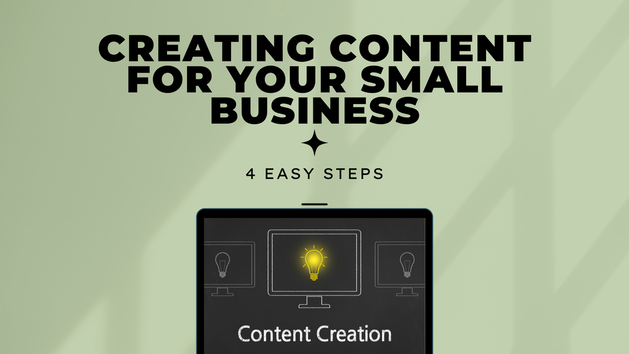Creating Content for Your Small Business - 4 Easy StepsAre you looking for ways to create high-quality content for your small business? Whether you're looking to attract new customers or keep your current ones engaged, content marketing is a great way to do it. But in the content marketing world, one size doesn't fit all. Content creation for small businesses involves strategy uniquely crafted for each business and its target audience. Content creation starts and ends with right-fit clients. If you miss the mark on reaching the ideal fit for you and your customer, you'll have a hard time building long-term client relationships. Which is what you really want, yes? So, let's start there — the ideal audience. Creating effective, high-quality content truly starts there. 1. Identify your target audience (i.e. right-fit client). When creating content for a small business, it's important to identify your target audience — the people I like to call right-fit clients. Do you know who you're trying to reach? The folks that your skills and personality serve best. Those who like you and like your work. Those you enjoy working for and with. Once you know your target audience, you can create content that's relevant and interesting to them. How do you know who your target audience is? This is a question small business owners commonly struggle with. When you're just starting out, it can be a little more difficult to decide who your right-fit clients are. When you're more established as a small business, you've got more data to work with. But it's important not to wait until you're established to narrow your focus to a specific market. Do your best to identify your target market early on. For established small business owners, one way to identify your target audience is to think about who your current customers are.
The answer to these questions will help you determine who your best-fit clients are. They're a key to content creation for small business. When you have the answers to the questions about who they are, you can start to create content that appeals to them and answers the questions they're asking. For example, if you sell women's clothing, you could create content that discusses current fashion trends, offers styling tips, or shares stories about real women who have successfully built a comfortable and trendy wardrobe on a shoestring budget. If you sell home improvement products, you could create content that discusses popular home improvement trends, offers advice on how to complete common projects, or showcases before-and-after pictures of projects that you completed. The key to content creation for small businesses is to think about what your right-fit audience needs to know and wants to hear — and then create content that speaks to their interests. Post it across multiple channels for maximum reach. 2. Create content that's engaging and interesting, and that provides value to the reader. It can be really easy to focus on ourselves when creating content, but it's so important to think about content creation the same way you think about relationship building. Sure, you've got big plans for the content you're creating. You want it to build your authority and name recognition. You also want it to generate leads. But when you're talking to potential clients, you don't generally start off with a sales pitch, right? Or if you do, maybe you need to work on your networking skills! Creating content is another way of networking. It's another way of building relationships. So whether you're creating blog posts, newsletters, infographics, or social media posts, think about having a conversation with your clients and potential clients. What would say to them if you were sitting down to a cup of coffee with them? What kind of information are they looking for? What are the pain points they're looking to resolve? Address those pain points with conversational content that's providing the value your audience is looking for. When creating content for your small business, keep the following in mind:
3. Use a variety of formats and media to reach and engage potential customers. There are many different ways to create content for a small business. Create blog posts, social media posts, videos, infographics, and more. And you can use a variety of formats (text only, images + text, videos with live footage, scripted videos) to reach and engage potential customers. For example, if you’re a small business that provides professional services, you could create infographics that explain how you potential customers can benefit from your services. Or, if you’re a small business that sells products, you could create a blog post that discusses the benefits of your products. Just remember to keep the content client-focused. Solve the pain points of your right-fit clients! Oh, and did you know you can use data to help you create content? Data can be a little intimidating sometimes. But these days, it's usually not too difficult to find statistics for specific industries. So, if you have stats about your industry, or about your products or services, you can use that information to create content that's both informative and engaging... and speaks to the pain points of your ideal clients. Remember, when you're doing all that — writing blog posts, creating infographics, sending out newsletters — to also promote your content. Share your blog posts on social media. Send them to your email list. Post those infographics on your website. Maybe it goes without saying, but I'm going to say it anyway... The more you promote your content, the more people will see it and the more engaged they’ll be. 4. Track the performance of your content and adjust as needed. If one type of content is outperforming the others, focus more of your efforts on that type. If a particular channel or platform isn't working, try something else. How do you know how your content is performing? Well, for starters, you can take note of likes, comments, and shares. Are more people subscribing to your newsletter or following you on social media? If the answer's yes, keep doing what you're doing. If the answer's no, you'll want to rethink some things. And to be honest, just looking at likes, comments, and shares will help you get an idea of your content's performance. But that's not the full picture. No worries, though! Modern technology gives us some tools to help us dive a little deeper. They're called analytics tools. And don't let that scare you! Keep reading... :) These three tools make it easier than ever for you to understand what's happening with the content you're creating. Google Analytics When you own a small business, it's important to track your website traffic to get a good picture of your website's performance. Google Analytics is a free tool that can tell you how many people are visiting your website as a result of your content. In Google Analytics, you can also see where those people are coming from, what pages they're visiting, how long people are staying on your site, and which pages are causing them to leave. All of this information can help you make changes to your site to keep people engaged longer. Here's a cheat sheet with a few key performance indicators you can analyze when looking at your website’s content through Google Analytics.
Social Media Analytics Social media analytics will tell you how many people are sharing or commenting on your content on social media.This is important because it tells you how successful your content is in engaging people on social media. How do you measure the performance of your social media channels?
If you find that your content is not being well-received, try adjusting your tone, the topics you're covering, or the images you're using. Also test different types of content to see what works best for your audience. Email Marketing Analytics Email marketing analytics will tell you how many people are opening and clicking through your email content. Analyzing your email marketing content can help you determine its overall effectiveness. By analyzing the data, you can see:
This information can help you to tweak your email content to make sure it's more engaging for your subscribers and more likely to be successful. Did you know email marketing analytics can also help you to determine the best time to send your emails? When you look at the data, you can see when your subscribers are most likely to open and click through your emails. Knowing this can help you schedule your emails for the times when they're most likely to be seen and acted on. A Few Final Words on Successful Small Business Content Marketing Remember, there's no one-size-fits-all formula of content creation for small businesses. The content creation process varies depending on each small business's specific goals and unique target audience. What's important for small business owners working hard to create effective content is understanding who their right-fit clients are, creating content that's relevant and solves the pain points of that audience, using a variety of formats and media to reach and engage potential customers, and keeping track of the performance of the content. Additionally, small businesses should make sure their website is updated regularly with new and relevant content and that they're actively engaging with their audience through social media and other online channels.
Remember that content marketing is a long game. You're not going to see results overnight, so be patient. If you're consistently planning your content, keeping it client-focused, tracking its performance, and adjusting it as needed, you'll see results. Looking for help planning and creating content that adequately addresses and solves the pain of your right-fit clients? Reach out. |
Julie J. NovaraJulie's a copy and content writer for small businesses making a big difference! Archives
August 2022
Categories
All
|
|
© 2023, Julie Johnson Writing Services PO Box 616 Alamance, NC 27201 (336) 539-1655 ALL RIGHTS RESERVED. |













 RSS Feed
RSS Feed
